Information Technology Project: Student Engagement and Governance
VerifiedAdded on 2022/11/26
|26
|6341
|368
Project
AI Summary
This Information Technology Project presents a comprehensive solution to enhance student engagement and decision-making within a university setting. The project comprises two key components: a student leadership framework and a digital platform, which is designed to improve communication, collaboration, and governance. The student leadership framework aims to unite student leadership positions, including representatives from the University Council, Academic Board, Faculty Boards, and Student Representative Council, as well as academic societies. This framework provides the foundation for the digital platform, which is envisioned as a web portal named 'iEngage' that will serve as a central hub for information, resources, and communication. The project also details the data sets to be used in the digital platform, including information on student leadership positions, university governance meetings, and student resources. The report identifies the challenges faced by current student leaders, such as a lack of experience and limited communication, and proposes the digital platform to address these issues. The implementation strategy involves the creation of a student leadership group, which will enhance student representation and facilitate upward and downward communication within the university. The project emphasizes the importance of student unity, inter-campus engagement, and representation in the university council to foster a more inclusive and responsive environment.
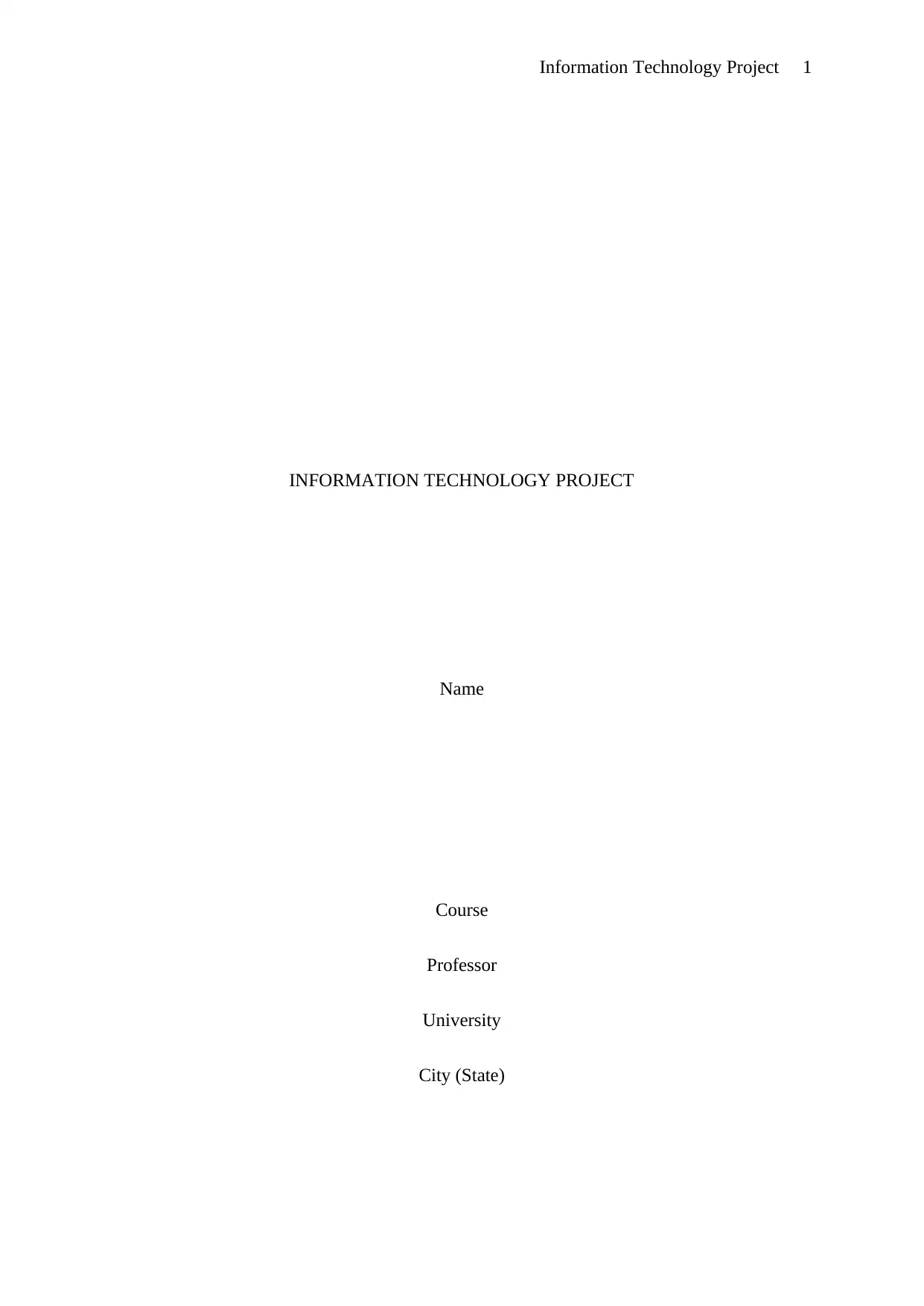
Information Technology Project 1
INFORMATION TECHNOLOGY PROJECT
Name
Course
Professor
University
City (State)
INFORMATION TECHNOLOGY PROJECT
Name
Course
Professor
University
City (State)
Paraphrase This Document
Need a fresh take? Get an instant paraphrase of this document with our AI Paraphraser
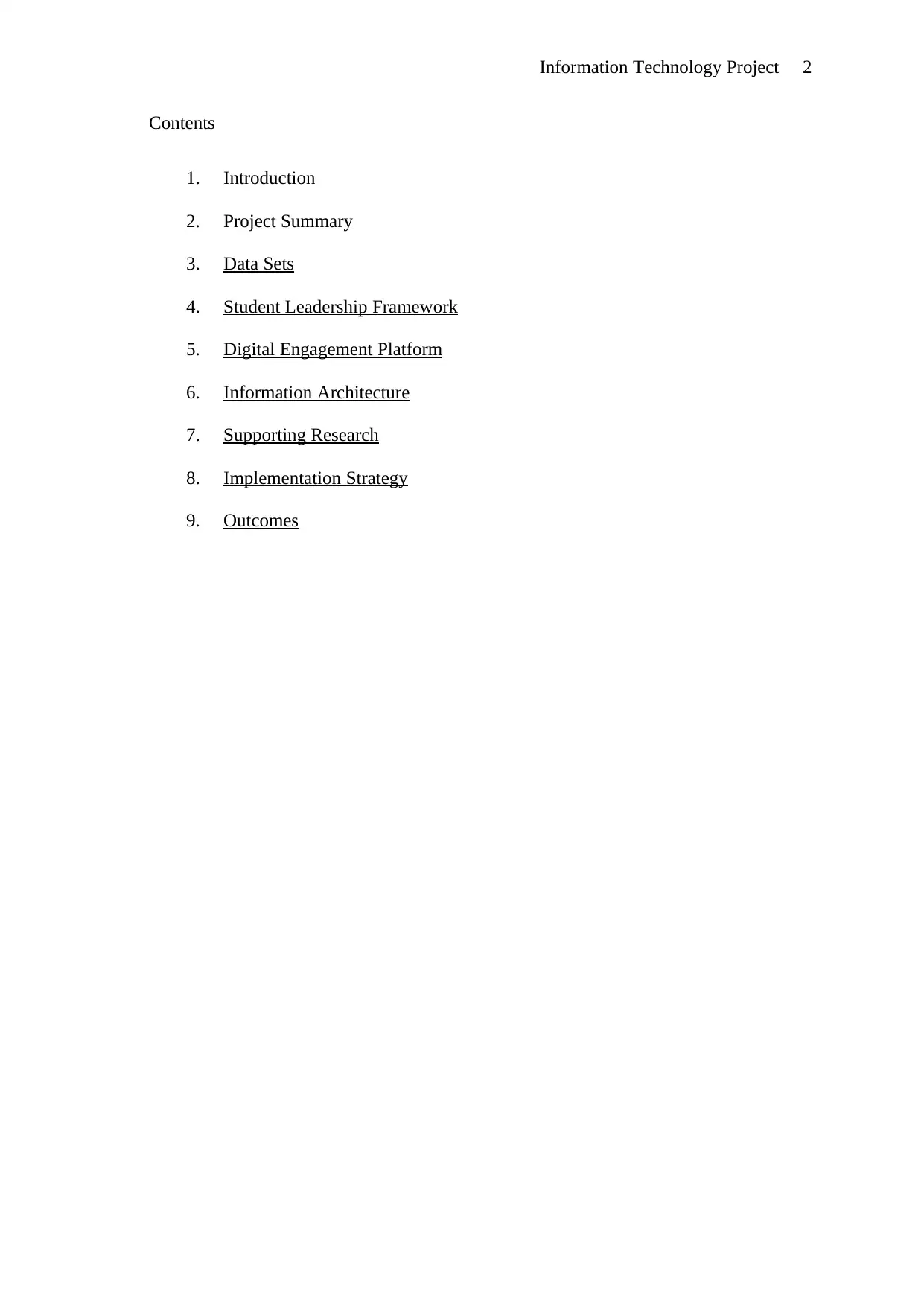
Information Technology Project 2
Contents
1. Introduction
2. Project Summary
3. Data Sets
4. Student Leadership Framework
5. Digital Engagement Platform
6. Information Architecture
7. Supporting Research
8. Implementation Strategy
9. Outcomes
Contents
1. Introduction
2. Project Summary
3. Data Sets
4. Student Leadership Framework
5. Digital Engagement Platform
6. Information Architecture
7. Supporting Research
8. Implementation Strategy
9. Outcomes
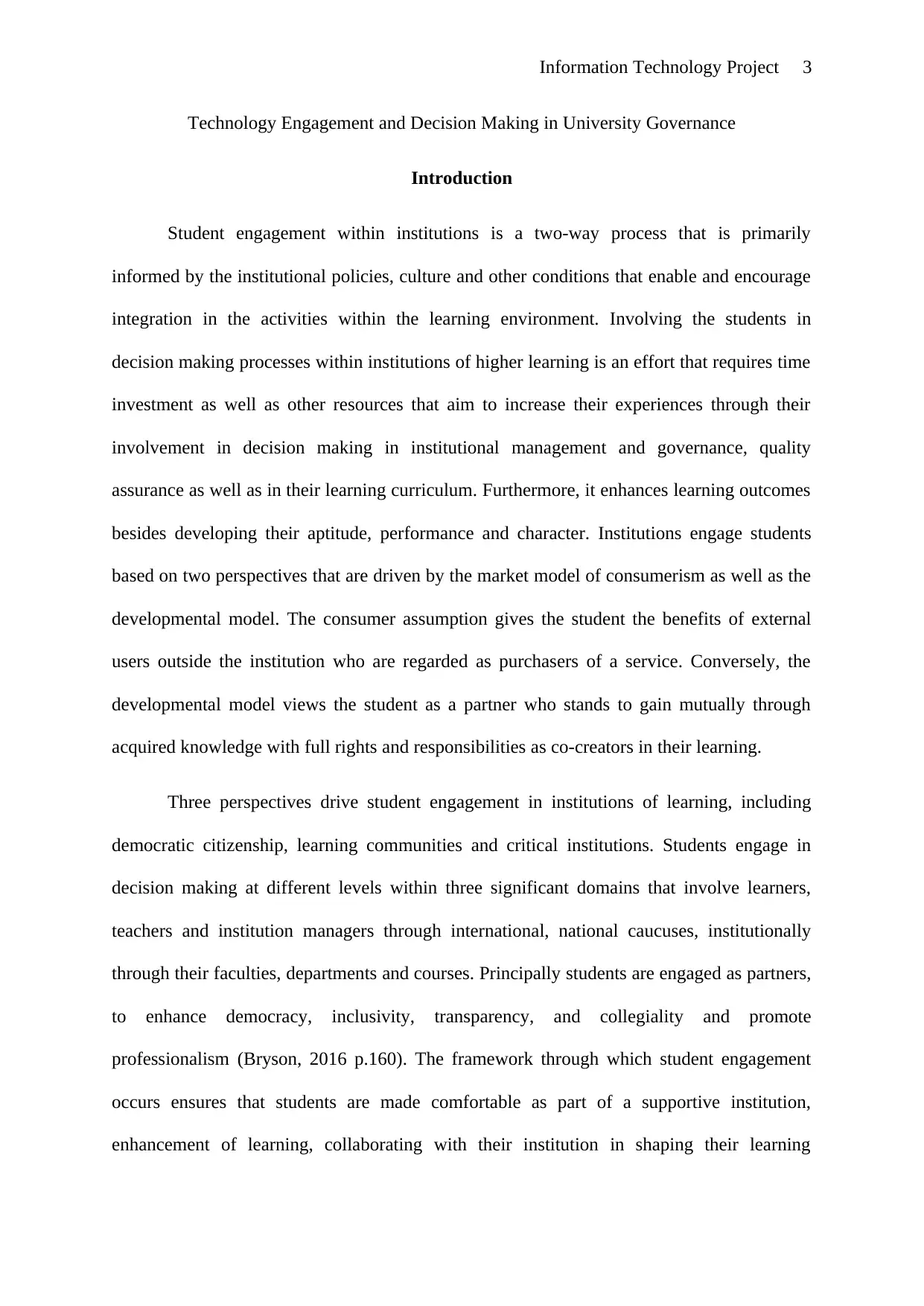
Information Technology Project 3
Technology Engagement and Decision Making in University Governance
Introduction
Student engagement within institutions is a two-way process that is primarily
informed by the institutional policies, culture and other conditions that enable and encourage
integration in the activities within the learning environment. Involving the students in
decision making processes within institutions of higher learning is an effort that requires time
investment as well as other resources that aim to increase their experiences through their
involvement in decision making in institutional management and governance, quality
assurance as well as in their learning curriculum. Furthermore, it enhances learning outcomes
besides developing their aptitude, performance and character. Institutions engage students
based on two perspectives that are driven by the market model of consumerism as well as the
developmental model. The consumer assumption gives the student the benefits of external
users outside the institution who are regarded as purchasers of a service. Conversely, the
developmental model views the student as a partner who stands to gain mutually through
acquired knowledge with full rights and responsibilities as co-creators in their learning.
Three perspectives drive student engagement in institutions of learning, including
democratic citizenship, learning communities and critical institutions. Students engage in
decision making at different levels within three significant domains that involve learners,
teachers and institution managers through international, national caucuses, institutionally
through their faculties, departments and courses. Principally students are engaged as partners,
to enhance democracy, inclusivity, transparency, and collegiality and promote
professionalism (Bryson, 2016 p.160). The framework through which student engagement
occurs ensures that students are made comfortable as part of a supportive institution,
enhancement of learning, collaborating with their institution in shaping their learning
Technology Engagement and Decision Making in University Governance
Introduction
Student engagement within institutions is a two-way process that is primarily
informed by the institutional policies, culture and other conditions that enable and encourage
integration in the activities within the learning environment. Involving the students in
decision making processes within institutions of higher learning is an effort that requires time
investment as well as other resources that aim to increase their experiences through their
involvement in decision making in institutional management and governance, quality
assurance as well as in their learning curriculum. Furthermore, it enhances learning outcomes
besides developing their aptitude, performance and character. Institutions engage students
based on two perspectives that are driven by the market model of consumerism as well as the
developmental model. The consumer assumption gives the student the benefits of external
users outside the institution who are regarded as purchasers of a service. Conversely, the
developmental model views the student as a partner who stands to gain mutually through
acquired knowledge with full rights and responsibilities as co-creators in their learning.
Three perspectives drive student engagement in institutions of learning, including
democratic citizenship, learning communities and critical institutions. Students engage in
decision making at different levels within three significant domains that involve learners,
teachers and institution managers through international, national caucuses, institutionally
through their faculties, departments and courses. Principally students are engaged as partners,
to enhance democracy, inclusivity, transparency, and collegiality and promote
professionalism (Bryson, 2016 p.160). The framework through which student engagement
occurs ensures that students are made comfortable as part of a supportive institution,
enhancement of learning, collaborating with their institution in shaping their learning
⊘ This is a preview!⊘
Do you want full access?
Subscribe today to unlock all pages.

Trusted by 1+ million students worldwide
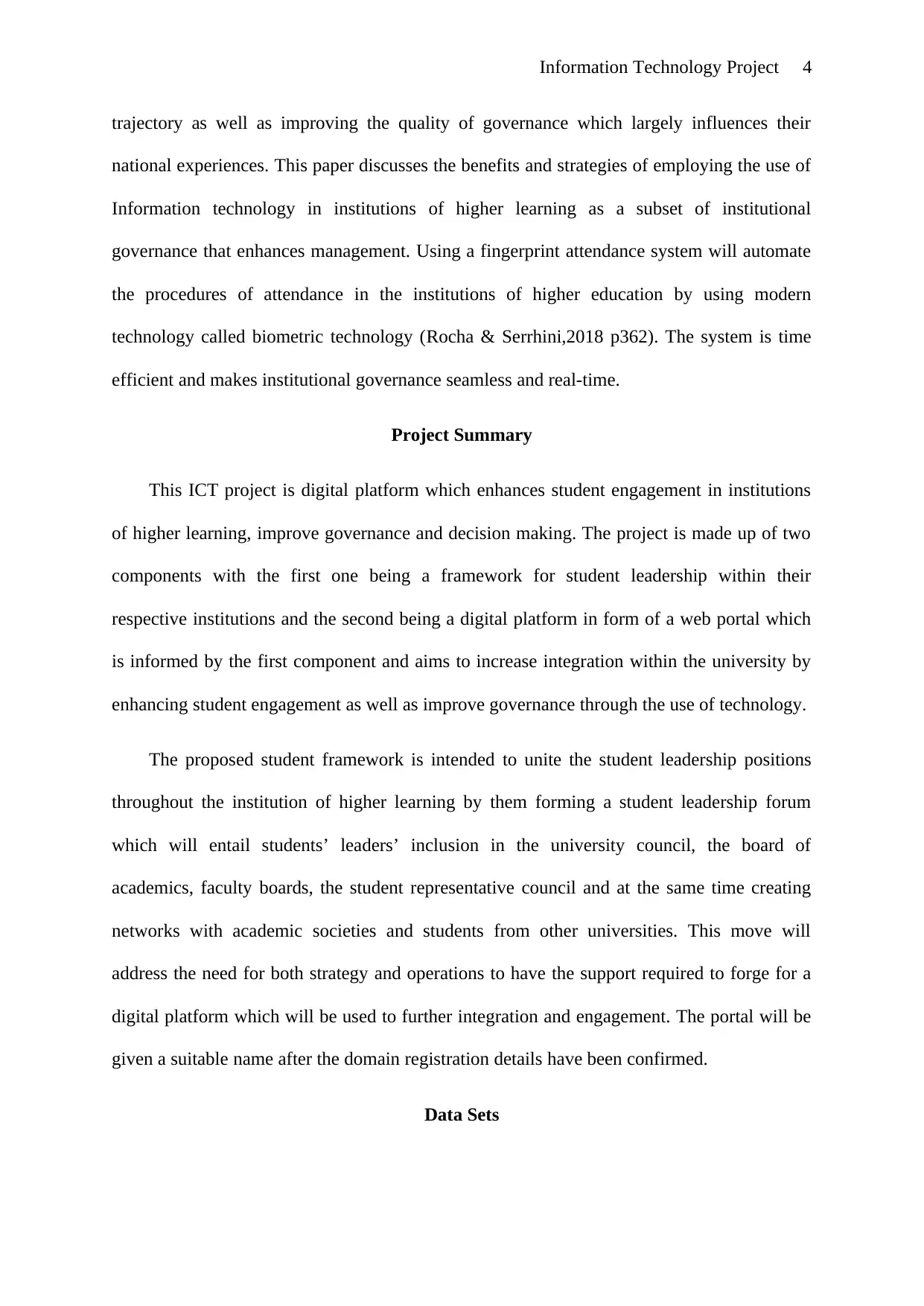
Information Technology Project 4
trajectory as well as improving the quality of governance which largely influences their
national experiences. This paper discusses the benefits and strategies of employing the use of
Information technology in institutions of higher learning as a subset of institutional
governance that enhances management. Using a fingerprint attendance system will automate
the procedures of attendance in the institutions of higher education by using modern
technology called biometric technology (Rocha & Serrhini,2018 p362). The system is time
efficient and makes institutional governance seamless and real-time.
Project Summary
This ICT project is digital platform which enhances student engagement in institutions
of higher learning, improve governance and decision making. The project is made up of two
components with the first one being a framework for student leadership within their
respective institutions and the second being a digital platform in form of a web portal which
is informed by the first component and aims to increase integration within the university by
enhancing student engagement as well as improve governance through the use of technology.
The proposed student framework is intended to unite the student leadership positions
throughout the institution of higher learning by them forming a student leadership forum
which will entail students’ leaders’ inclusion in the university council, the board of
academics, faculty boards, the student representative council and at the same time creating
networks with academic societies and students from other universities. This move will
address the need for both strategy and operations to have the support required to forge for a
digital platform which will be used to further integration and engagement. The portal will be
given a suitable name after the domain registration details have been confirmed.
Data Sets
trajectory as well as improving the quality of governance which largely influences their
national experiences. This paper discusses the benefits and strategies of employing the use of
Information technology in institutions of higher learning as a subset of institutional
governance that enhances management. Using a fingerprint attendance system will automate
the procedures of attendance in the institutions of higher education by using modern
technology called biometric technology (Rocha & Serrhini,2018 p362). The system is time
efficient and makes institutional governance seamless and real-time.
Project Summary
This ICT project is digital platform which enhances student engagement in institutions
of higher learning, improve governance and decision making. The project is made up of two
components with the first one being a framework for student leadership within their
respective institutions and the second being a digital platform in form of a web portal which
is informed by the first component and aims to increase integration within the university by
enhancing student engagement as well as improve governance through the use of technology.
The proposed student framework is intended to unite the student leadership positions
throughout the institution of higher learning by them forming a student leadership forum
which will entail students’ leaders’ inclusion in the university council, the board of
academics, faculty boards, the student representative council and at the same time creating
networks with academic societies and students from other universities. This move will
address the need for both strategy and operations to have the support required to forge for a
digital platform which will be used to further integration and engagement. The portal will be
given a suitable name after the domain registration details have been confirmed.
Data Sets
Paraphrase This Document
Need a fresh take? Get an instant paraphrase of this document with our AI Paraphraser
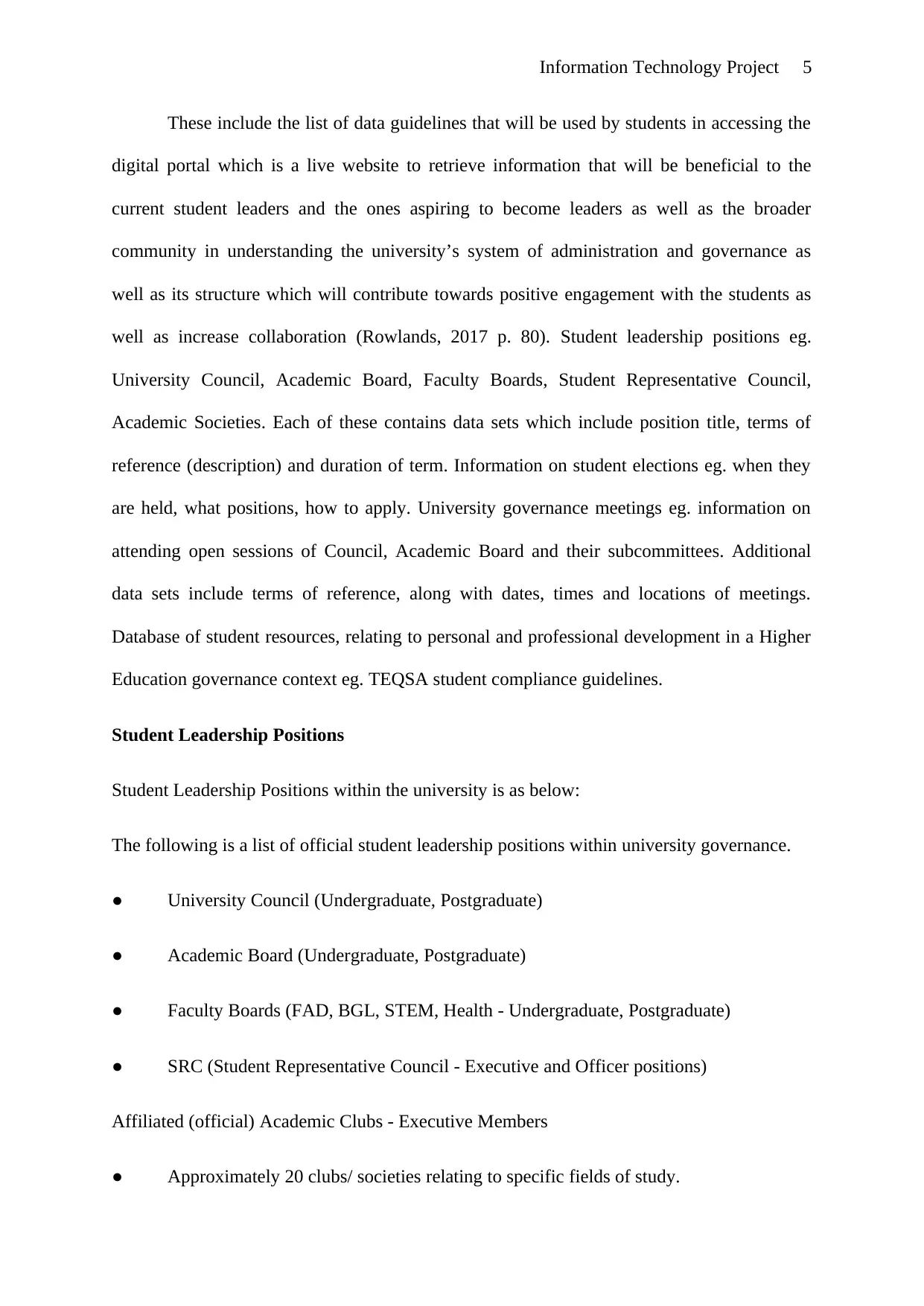
Information Technology Project 5
These include the list of data guidelines that will be used by students in accessing the
digital portal which is a live website to retrieve information that will be beneficial to the
current student leaders and the ones aspiring to become leaders as well as the broader
community in understanding the university’s system of administration and governance as
well as its structure which will contribute towards positive engagement with the students as
well as increase collaboration (Rowlands, 2017 p. 80). Student leadership positions eg.
University Council, Academic Board, Faculty Boards, Student Representative Council,
Academic Societies. Each of these contains data sets which include position title, terms of
reference (description) and duration of term. Information on student elections eg. when they
are held, what positions, how to apply. University governance meetings eg. information on
attending open sessions of Council, Academic Board and their subcommittees. Additional
data sets include terms of reference, along with dates, times and locations of meetings.
Database of student resources, relating to personal and professional development in a Higher
Education governance context eg. TEQSA student compliance guidelines.
Student Leadership Positions
Student Leadership Positions within the university is as below:
The following is a list of official student leadership positions within university governance.
● University Council (Undergraduate, Postgraduate)
● Academic Board (Undergraduate, Postgraduate)
● Faculty Boards (FAD, BGL, STEM, Health - Undergraduate, Postgraduate)
● SRC (Student Representative Council - Executive and Officer positions)
Affiliated (official) Academic Clubs - Executive Members
● Approximately 20 clubs/ societies relating to specific fields of study.
These include the list of data guidelines that will be used by students in accessing the
digital portal which is a live website to retrieve information that will be beneficial to the
current student leaders and the ones aspiring to become leaders as well as the broader
community in understanding the university’s system of administration and governance as
well as its structure which will contribute towards positive engagement with the students as
well as increase collaboration (Rowlands, 2017 p. 80). Student leadership positions eg.
University Council, Academic Board, Faculty Boards, Student Representative Council,
Academic Societies. Each of these contains data sets which include position title, terms of
reference (description) and duration of term. Information on student elections eg. when they
are held, what positions, how to apply. University governance meetings eg. information on
attending open sessions of Council, Academic Board and their subcommittees. Additional
data sets include terms of reference, along with dates, times and locations of meetings.
Database of student resources, relating to personal and professional development in a Higher
Education governance context eg. TEQSA student compliance guidelines.
Student Leadership Positions
Student Leadership Positions within the university is as below:
The following is a list of official student leadership positions within university governance.
● University Council (Undergraduate, Postgraduate)
● Academic Board (Undergraduate, Postgraduate)
● Faculty Boards (FAD, BGL, STEM, Health - Undergraduate, Postgraduate)
● SRC (Student Representative Council - Executive and Officer positions)
Affiliated (official) Academic Clubs - Executive Members
● Approximately 20 clubs/ societies relating to specific fields of study.
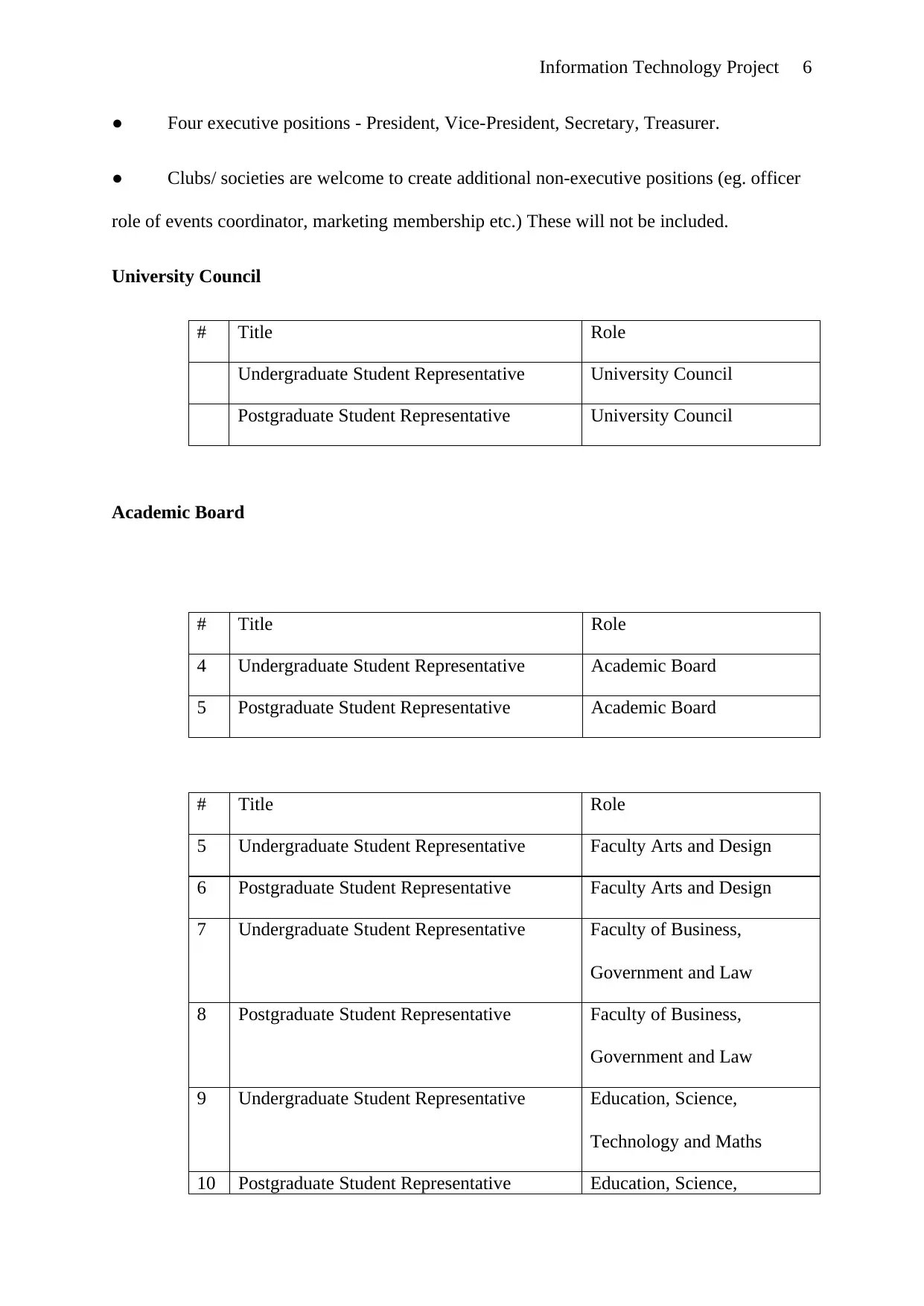
Information Technology Project 6
● Four executive positions - President, Vice-President, Secretary, Treasurer.
● Clubs/ societies are welcome to create additional non-executive positions (eg. officer
role of events coordinator, marketing membership etc.) These will not be included.
University Council
# Title Role
Undergraduate Student Representative University Council
Postgraduate Student Representative University Council
Academic Board
# Title Role
4 Undergraduate Student Representative Academic Board
5 Postgraduate Student Representative Academic Board
# Title Role
5 Undergraduate Student Representative Faculty Arts and Design
6 Postgraduate Student Representative Faculty Arts and Design
7 Undergraduate Student Representative Faculty of Business,
Government and Law
8 Postgraduate Student Representative Faculty of Business,
Government and Law
9 Undergraduate Student Representative Education, Science,
Technology and Maths
10 Postgraduate Student Representative Education, Science,
● Four executive positions - President, Vice-President, Secretary, Treasurer.
● Clubs/ societies are welcome to create additional non-executive positions (eg. officer
role of events coordinator, marketing membership etc.) These will not be included.
University Council
# Title Role
Undergraduate Student Representative University Council
Postgraduate Student Representative University Council
Academic Board
# Title Role
4 Undergraduate Student Representative Academic Board
5 Postgraduate Student Representative Academic Board
# Title Role
5 Undergraduate Student Representative Faculty Arts and Design
6 Postgraduate Student Representative Faculty Arts and Design
7 Undergraduate Student Representative Faculty of Business,
Government and Law
8 Postgraduate Student Representative Faculty of Business,
Government and Law
9 Undergraduate Student Representative Education, Science,
Technology and Maths
10 Postgraduate Student Representative Education, Science,
⊘ This is a preview!⊘
Do you want full access?
Subscribe today to unlock all pages.

Trusted by 1+ million students worldwide
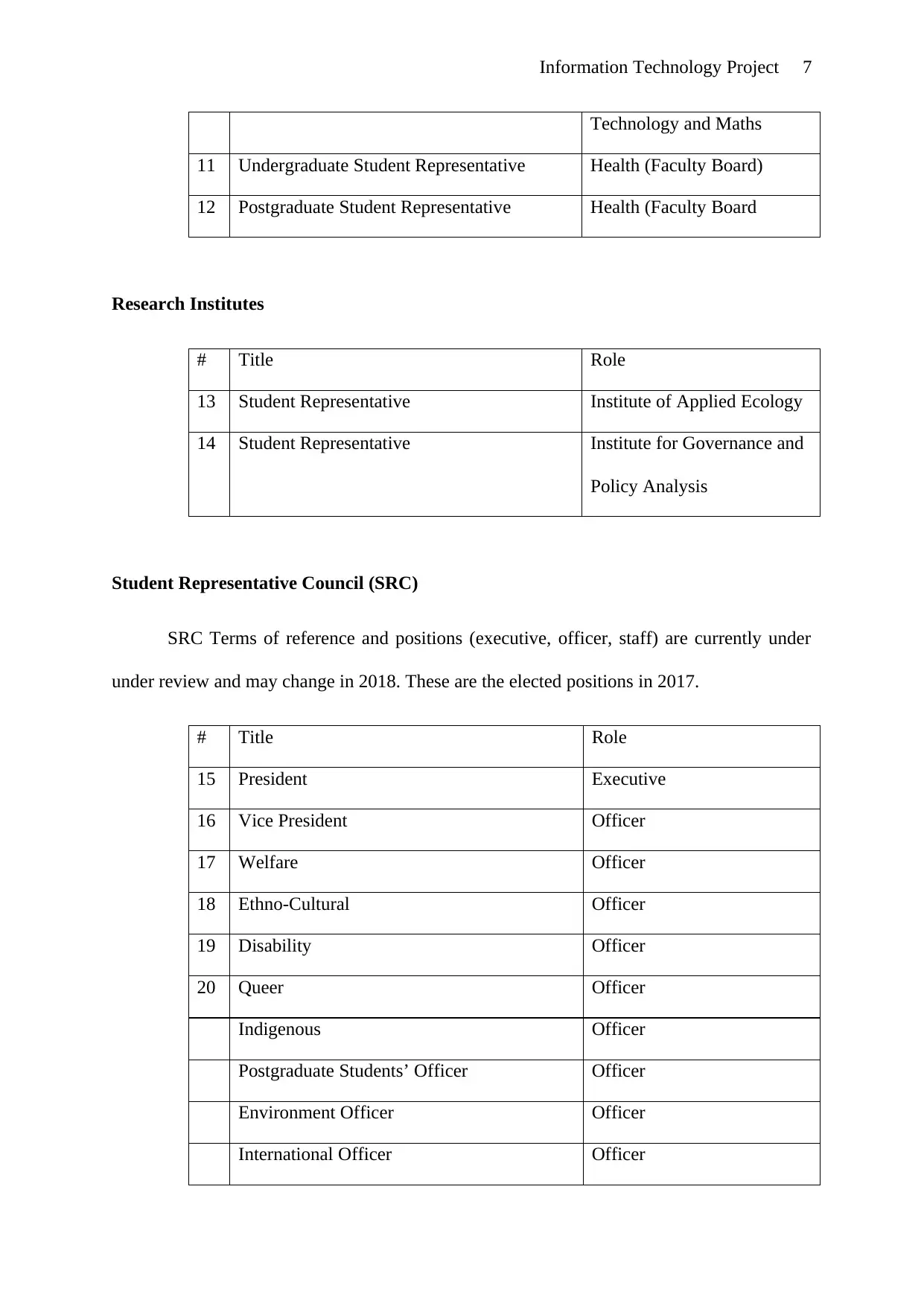
Information Technology Project 7
Technology and Maths
11 Undergraduate Student Representative Health (Faculty Board)
12 Postgraduate Student Representative Health (Faculty Board
Research Institutes
# Title Role
13 Student Representative Institute of Applied Ecology
14 Student Representative Institute for Governance and
Policy Analysis
Student Representative Council (SRC)
SRC Terms of reference and positions (executive, officer, staff) are currently under
under review and may change in 2018. These are the elected positions in 2017.
# Title Role
15 President Executive
16 Vice President Officer
17 Welfare Officer
18 Ethno-Cultural Officer
19 Disability Officer
20 Queer Officer
Indigenous Officer
Postgraduate Students’ Officer Officer
Environment Officer Officer
International Officer Officer
Technology and Maths
11 Undergraduate Student Representative Health (Faculty Board)
12 Postgraduate Student Representative Health (Faculty Board
Research Institutes
# Title Role
13 Student Representative Institute of Applied Ecology
14 Student Representative Institute for Governance and
Policy Analysis
Student Representative Council (SRC)
SRC Terms of reference and positions (executive, officer, staff) are currently under
under review and may change in 2018. These are the elected positions in 2017.
# Title Role
15 President Executive
16 Vice President Officer
17 Welfare Officer
18 Ethno-Cultural Officer
19 Disability Officer
20 Queer Officer
Indigenous Officer
Postgraduate Students’ Officer Officer
Environment Officer Officer
International Officer Officer
Paraphrase This Document
Need a fresh take? Get an instant paraphrase of this document with our AI Paraphraser
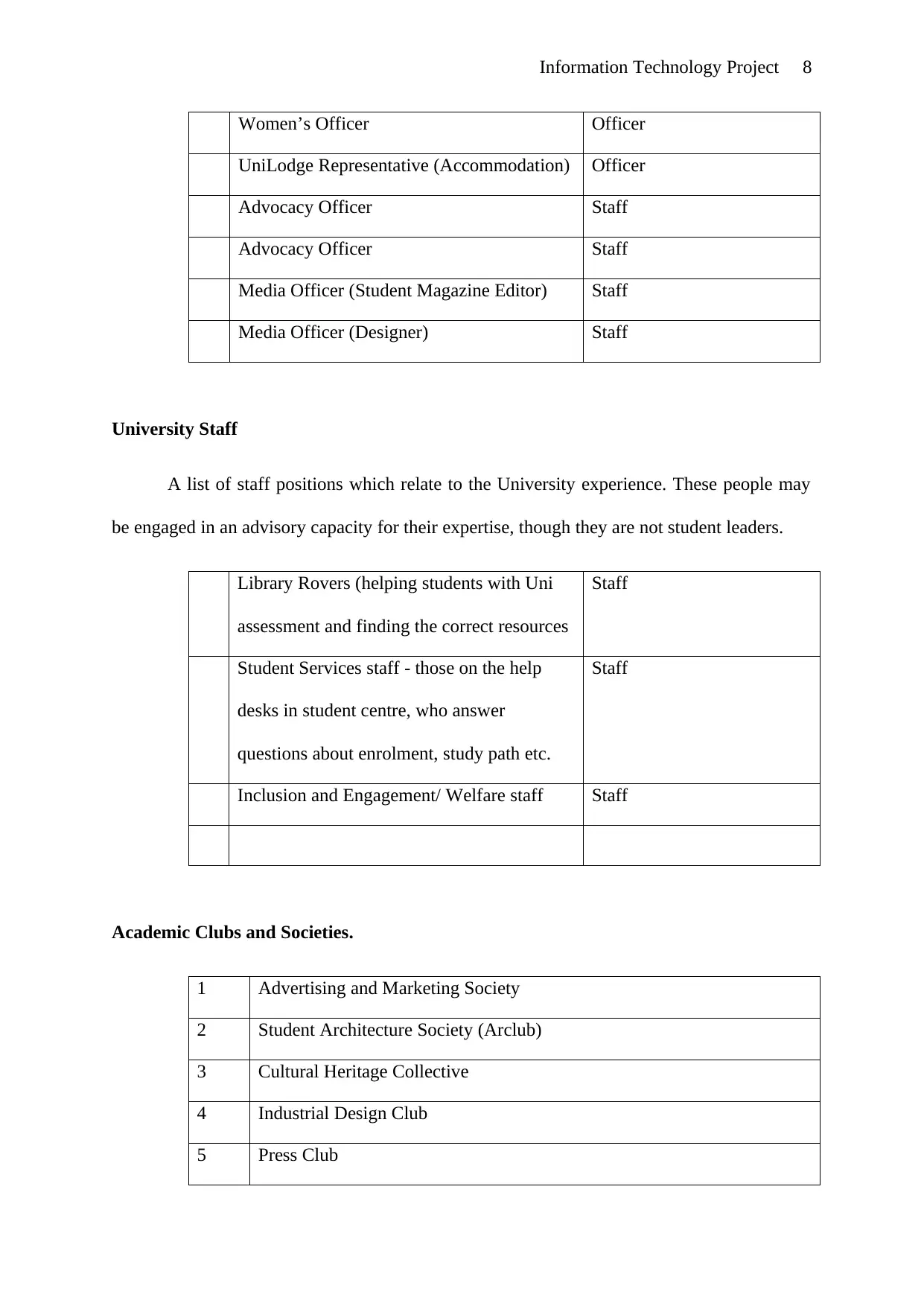
Information Technology Project 8
Women’s Officer Officer
UniLodge Representative (Accommodation) Officer
Advocacy Officer Staff
Advocacy Officer Staff
Media Officer (Student Magazine Editor) Staff
Media Officer (Designer) Staff
University Staff
A list of staff positions which relate to the University experience. These people may
be engaged in an advisory capacity for their expertise, though they are not student leaders.
Library Rovers (helping students with Uni
assessment and finding the correct resources
Staff
Student Services staff - those on the help
desks in student centre, who answer
questions about enrolment, study path etc.
Staff
Inclusion and Engagement/ Welfare staff Staff
Academic Clubs and Societies.
1 Advertising and Marketing Society
2 Student Architecture Society (Arclub)
3 Cultural Heritage Collective
4 Industrial Design Club
5 Press Club
Women’s Officer Officer
UniLodge Representative (Accommodation) Officer
Advocacy Officer Staff
Advocacy Officer Staff
Media Officer (Student Magazine Editor) Staff
Media Officer (Designer) Staff
University Staff
A list of staff positions which relate to the University experience. These people may
be engaged in an advisory capacity for their expertise, though they are not student leaders.
Library Rovers (helping students with Uni
assessment and finding the correct resources
Staff
Student Services staff - those on the help
desks in student centre, who answer
questions about enrolment, study path etc.
Staff
Inclusion and Engagement/ Welfare staff Staff
Academic Clubs and Societies.
1 Advertising and Marketing Society
2 Student Architecture Society (Arclub)
3 Cultural Heritage Collective
4 Industrial Design Club
5 Press Club
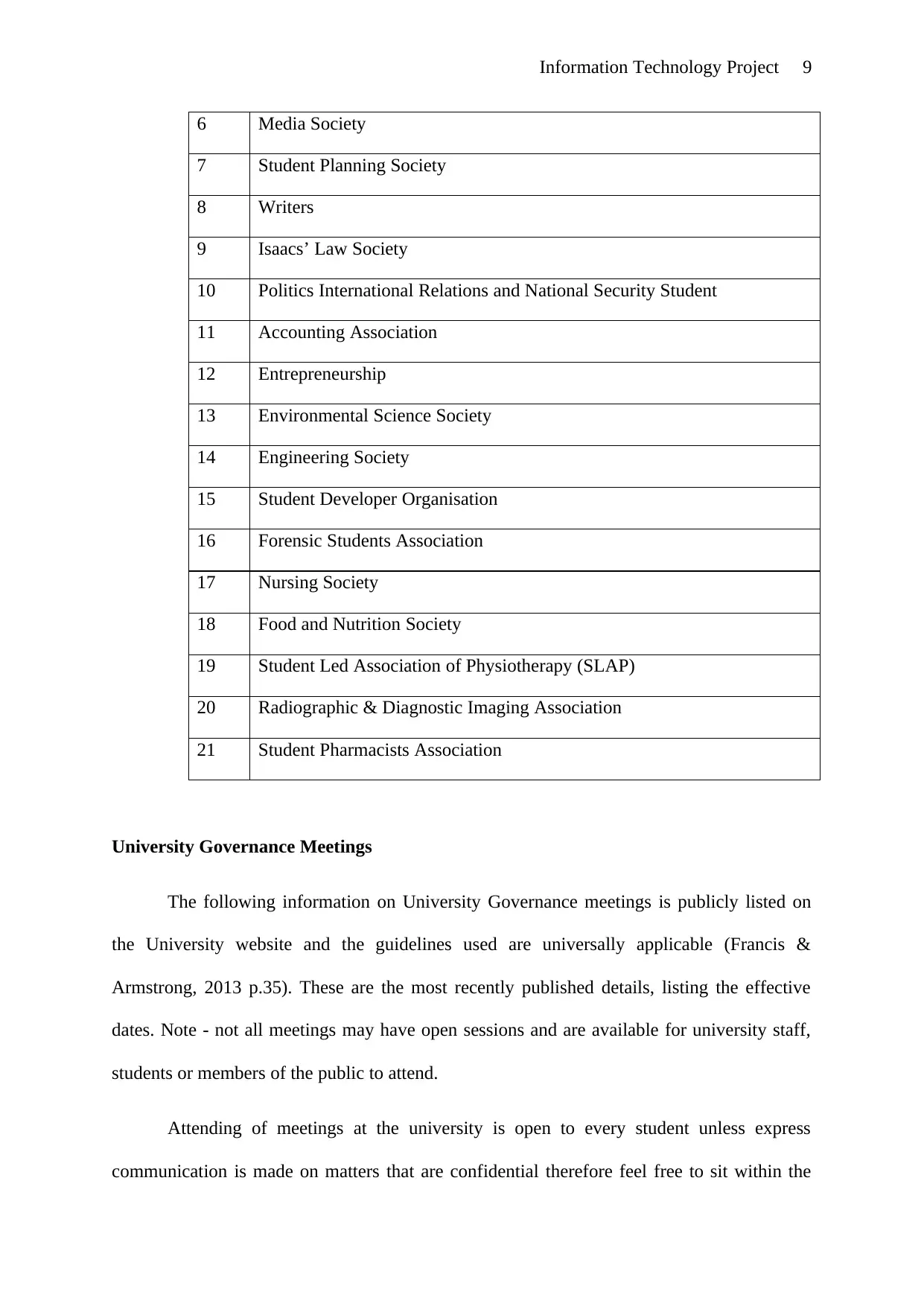
Information Technology Project 9
6 Media Society
7 Student Planning Society
8 Writers
9 Isaacs’ Law Society
10 Politics International Relations and National Security Student
11 Accounting Association
12 Entrepreneurship
13 Environmental Science Society
14 Engineering Society
15 Student Developer Organisation
16 Forensic Students Association
17 Nursing Society
18 Food and Nutrition Society
19 Student Led Association of Physiotherapy (SLAP)
20 Radiographic & Diagnostic Imaging Association
21 Student Pharmacists Association
University Governance Meetings
The following information on University Governance meetings is publicly listed on
the University website and the guidelines used are universally applicable (Francis &
Armstrong, 2013 p.35). These are the most recently published details, listing the effective
dates. Note - not all meetings may have open sessions and are available for university staff,
students or members of the public to attend.
Attending of meetings at the university is open to every student unless express
communication is made on matters that are confidential therefore feel free to sit within the
6 Media Society
7 Student Planning Society
8 Writers
9 Isaacs’ Law Society
10 Politics International Relations and National Security Student
11 Accounting Association
12 Entrepreneurship
13 Environmental Science Society
14 Engineering Society
15 Student Developer Organisation
16 Forensic Students Association
17 Nursing Society
18 Food and Nutrition Society
19 Student Led Association of Physiotherapy (SLAP)
20 Radiographic & Diagnostic Imaging Association
21 Student Pharmacists Association
University Governance Meetings
The following information on University Governance meetings is publicly listed on
the University website and the guidelines used are universally applicable (Francis &
Armstrong, 2013 p.35). These are the most recently published details, listing the effective
dates. Note - not all meetings may have open sessions and are available for university staff,
students or members of the public to attend.
Attending of meetings at the university is open to every student unless express
communication is made on matters that are confidential therefore feel free to sit within the
⊘ This is a preview!⊘
Do you want full access?
Subscribe today to unlock all pages.

Trusted by 1+ million students worldwide
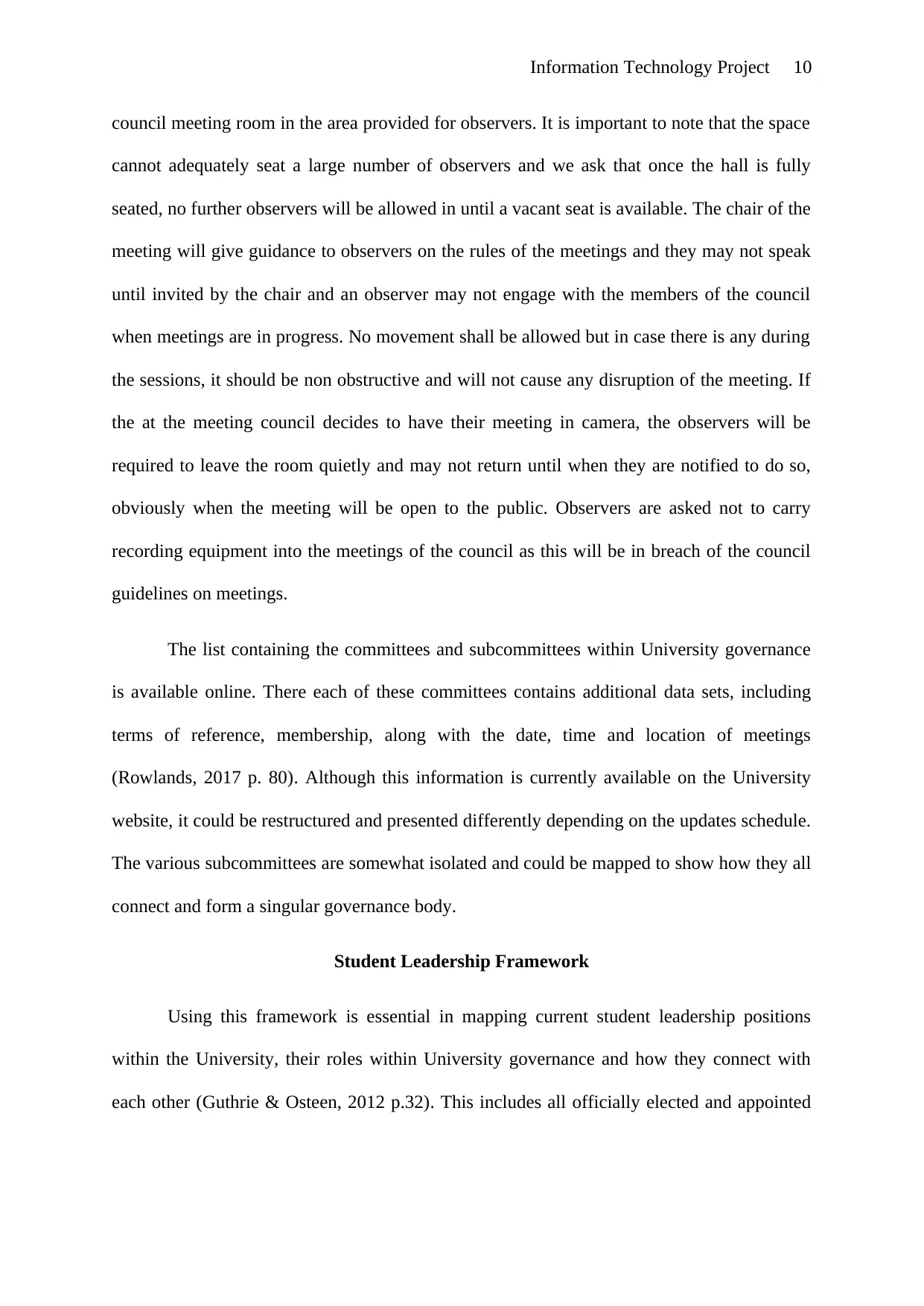
Information Technology Project 10
council meeting room in the area provided for observers. It is important to note that the space
cannot adequately seat a large number of observers and we ask that once the hall is fully
seated, no further observers will be allowed in until a vacant seat is available. The chair of the
meeting will give guidance to observers on the rules of the meetings and they may not speak
until invited by the chair and an observer may not engage with the members of the council
when meetings are in progress. No movement shall be allowed but in case there is any during
the sessions, it should be non obstructive and will not cause any disruption of the meeting. If
the at the meeting council decides to have their meeting in camera, the observers will be
required to leave the room quietly and may not return until when they are notified to do so,
obviously when the meeting will be open to the public. Observers are asked not to carry
recording equipment into the meetings of the council as this will be in breach of the council
guidelines on meetings.
The list containing the committees and subcommittees within University governance
is available online. There each of these committees contains additional data sets, including
terms of reference, membership, along with the date, time and location of meetings
(Rowlands, 2017 p. 80). Although this information is currently available on the University
website, it could be restructured and presented differently depending on the updates schedule.
The various subcommittees are somewhat isolated and could be mapped to show how they all
connect and form a singular governance body.
Student Leadership Framework
Using this framework is essential in mapping current student leadership positions
within the University, their roles within University governance and how they connect with
each other (Guthrie & Osteen, 2012 p.32). This includes all officially elected and appointed
council meeting room in the area provided for observers. It is important to note that the space
cannot adequately seat a large number of observers and we ask that once the hall is fully
seated, no further observers will be allowed in until a vacant seat is available. The chair of the
meeting will give guidance to observers on the rules of the meetings and they may not speak
until invited by the chair and an observer may not engage with the members of the council
when meetings are in progress. No movement shall be allowed but in case there is any during
the sessions, it should be non obstructive and will not cause any disruption of the meeting. If
the at the meeting council decides to have their meeting in camera, the observers will be
required to leave the room quietly and may not return until when they are notified to do so,
obviously when the meeting will be open to the public. Observers are asked not to carry
recording equipment into the meetings of the council as this will be in breach of the council
guidelines on meetings.
The list containing the committees and subcommittees within University governance
is available online. There each of these committees contains additional data sets, including
terms of reference, membership, along with the date, time and location of meetings
(Rowlands, 2017 p. 80). Although this information is currently available on the University
website, it could be restructured and presented differently depending on the updates schedule.
The various subcommittees are somewhat isolated and could be mapped to show how they all
connect and form a singular governance body.
Student Leadership Framework
Using this framework is essential in mapping current student leadership positions
within the University, their roles within University governance and how they connect with
each other (Guthrie & Osteen, 2012 p.32). This includes all officially elected and appointed
Paraphrase This Document
Need a fresh take? Get an instant paraphrase of this document with our AI Paraphraser
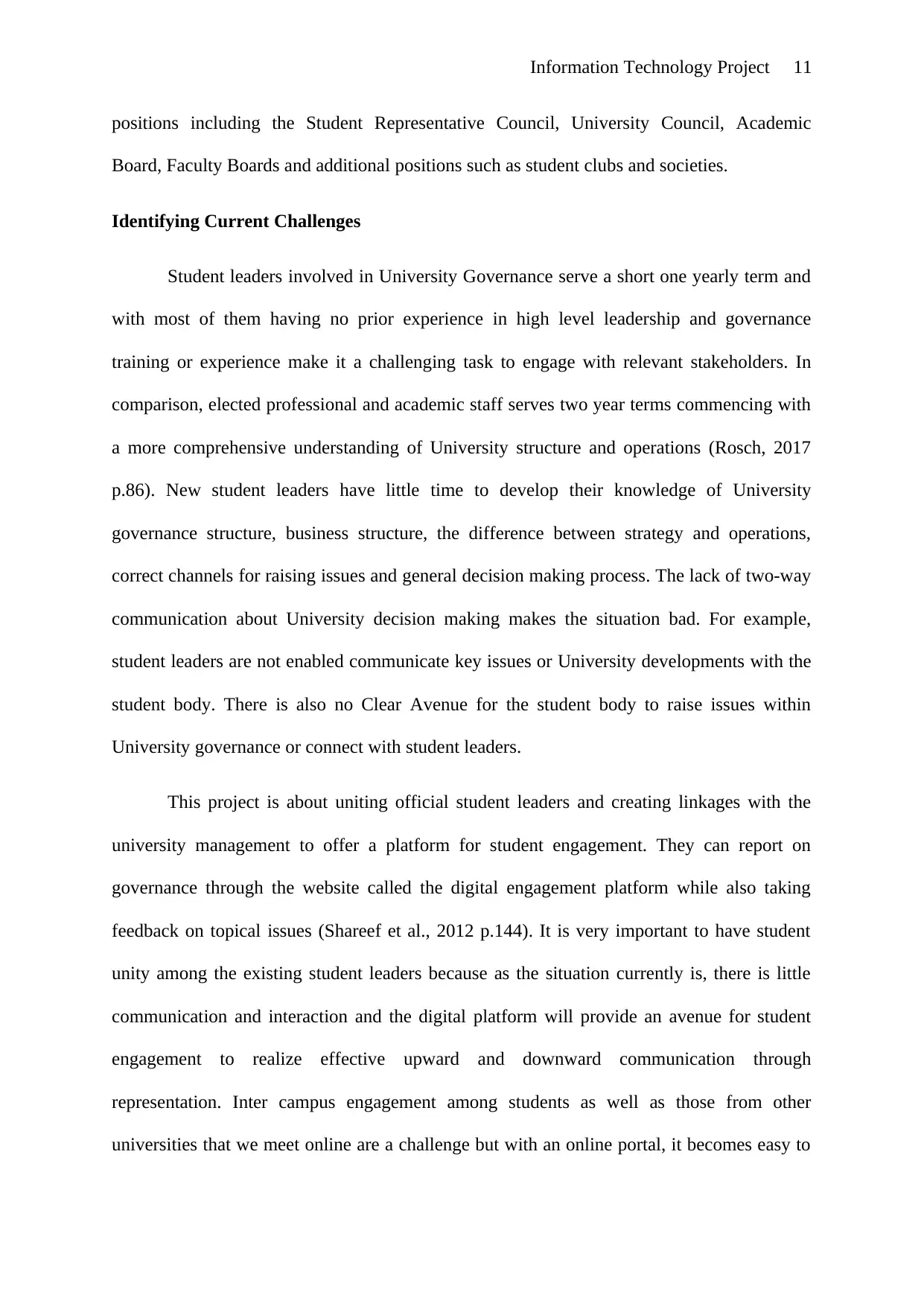
Information Technology Project 11
positions including the Student Representative Council, University Council, Academic
Board, Faculty Boards and additional positions such as student clubs and societies.
Identifying Current Challenges
Student leaders involved in University Governance serve a short one yearly term and
with most of them having no prior experience in high level leadership and governance
training or experience make it a challenging task to engage with relevant stakeholders. In
comparison, elected professional and academic staff serves two year terms commencing with
a more comprehensive understanding of University structure and operations (Rosch, 2017
p.86). New student leaders have little time to develop their knowledge of University
governance structure, business structure, the difference between strategy and operations,
correct channels for raising issues and general decision making process. The lack of two-way
communication about University decision making makes the situation bad. For example,
student leaders are not enabled communicate key issues or University developments with the
student body. There is also no Clear Avenue for the student body to raise issues within
University governance or connect with student leaders.
This project is about uniting official student leaders and creating linkages with the
university management to offer a platform for student engagement. They can report on
governance through the website called the digital engagement platform while also taking
feedback on topical issues (Shareef et al., 2012 p.144). It is very important to have student
unity among the existing student leaders because as the situation currently is, there is little
communication and interaction and the digital platform will provide an avenue for student
engagement to realize effective upward and downward communication through
representation. Inter campus engagement among students as well as those from other
universities that we meet online are a challenge but with an online portal, it becomes easy to
positions including the Student Representative Council, University Council, Academic
Board, Faculty Boards and additional positions such as student clubs and societies.
Identifying Current Challenges
Student leaders involved in University Governance serve a short one yearly term and
with most of them having no prior experience in high level leadership and governance
training or experience make it a challenging task to engage with relevant stakeholders. In
comparison, elected professional and academic staff serves two year terms commencing with
a more comprehensive understanding of University structure and operations (Rosch, 2017
p.86). New student leaders have little time to develop their knowledge of University
governance structure, business structure, the difference between strategy and operations,
correct channels for raising issues and general decision making process. The lack of two-way
communication about University decision making makes the situation bad. For example,
student leaders are not enabled communicate key issues or University developments with the
student body. There is also no Clear Avenue for the student body to raise issues within
University governance or connect with student leaders.
This project is about uniting official student leaders and creating linkages with the
university management to offer a platform for student engagement. They can report on
governance through the website called the digital engagement platform while also taking
feedback on topical issues (Shareef et al., 2012 p.144). It is very important to have student
unity among the existing student leaders because as the situation currently is, there is little
communication and interaction and the digital platform will provide an avenue for student
engagement to realize effective upward and downward communication through
representation. Inter campus engagement among students as well as those from other
universities that we meet online are a challenge but with an online portal, it becomes easy to
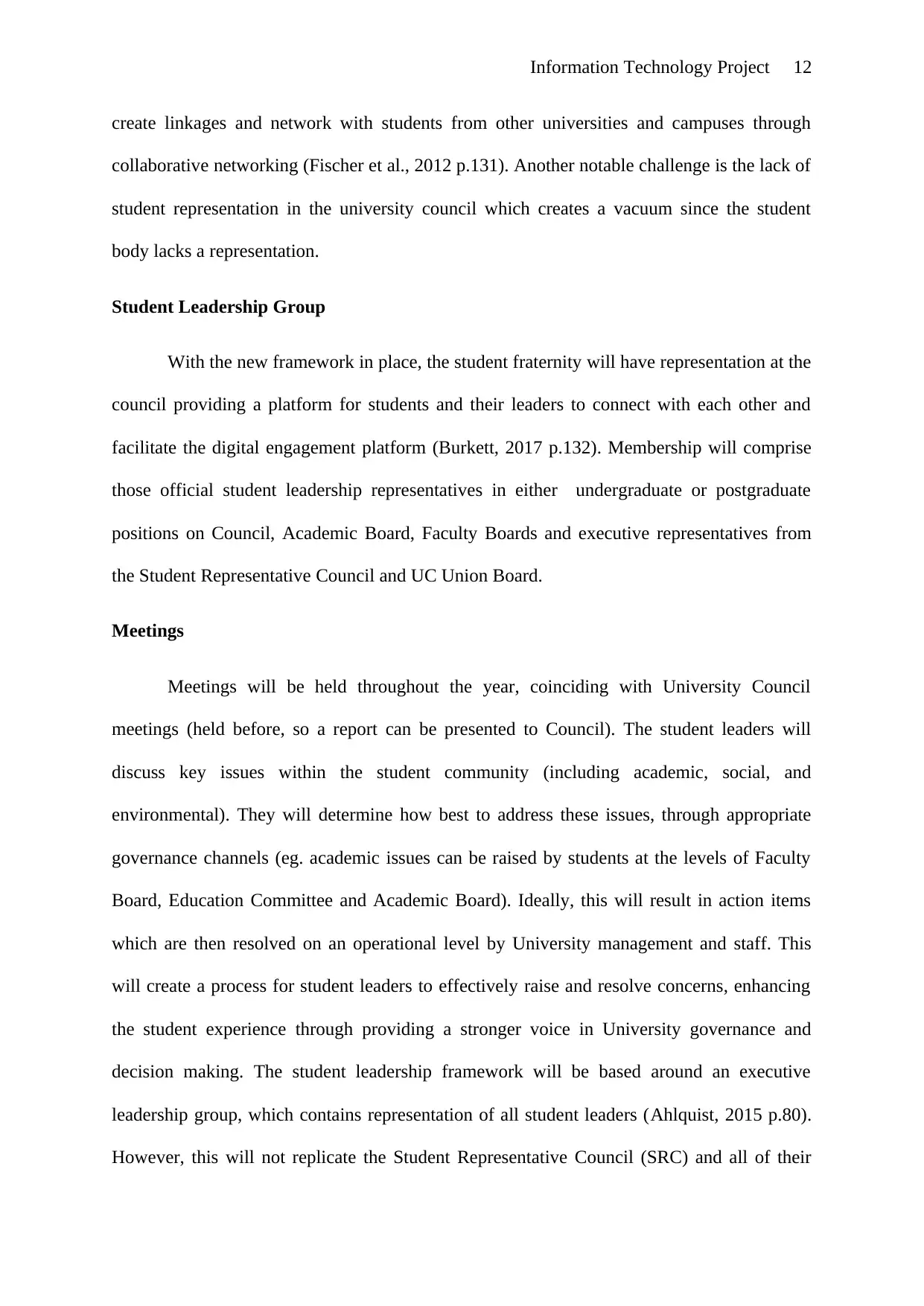
Information Technology Project 12
create linkages and network with students from other universities and campuses through
collaborative networking (Fischer et al., 2012 p.131). Another notable challenge is the lack of
student representation in the university council which creates a vacuum since the student
body lacks a representation.
Student Leadership Group
With the new framework in place, the student fraternity will have representation at the
council providing a platform for students and their leaders to connect with each other and
facilitate the digital engagement platform (Burkett, 2017 p.132). Membership will comprise
those official student leadership representatives in either undergraduate or postgraduate
positions on Council, Academic Board, Faculty Boards and executive representatives from
the Student Representative Council and UC Union Board.
Meetings
Meetings will be held throughout the year, coinciding with University Council
meetings (held before, so a report can be presented to Council). The student leaders will
discuss key issues within the student community (including academic, social, and
environmental). They will determine how best to address these issues, through appropriate
governance channels (eg. academic issues can be raised by students at the levels of Faculty
Board, Education Committee and Academic Board). Ideally, this will result in action items
which are then resolved on an operational level by University management and staff. This
will create a process for student leaders to effectively raise and resolve concerns, enhancing
the student experience through providing a stronger voice in University governance and
decision making. The student leadership framework will be based around an executive
leadership group, which contains representation of all student leaders (Ahlquist, 2015 p.80).
However, this will not replicate the Student Representative Council (SRC) and all of their
create linkages and network with students from other universities and campuses through
collaborative networking (Fischer et al., 2012 p.131). Another notable challenge is the lack of
student representation in the university council which creates a vacuum since the student
body lacks a representation.
Student Leadership Group
With the new framework in place, the student fraternity will have representation at the
council providing a platform for students and their leaders to connect with each other and
facilitate the digital engagement platform (Burkett, 2017 p.132). Membership will comprise
those official student leadership representatives in either undergraduate or postgraduate
positions on Council, Academic Board, Faculty Boards and executive representatives from
the Student Representative Council and UC Union Board.
Meetings
Meetings will be held throughout the year, coinciding with University Council
meetings (held before, so a report can be presented to Council). The student leaders will
discuss key issues within the student community (including academic, social, and
environmental). They will determine how best to address these issues, through appropriate
governance channels (eg. academic issues can be raised by students at the levels of Faculty
Board, Education Committee and Academic Board). Ideally, this will result in action items
which are then resolved on an operational level by University management and staff. This
will create a process for student leaders to effectively raise and resolve concerns, enhancing
the student experience through providing a stronger voice in University governance and
decision making. The student leadership framework will be based around an executive
leadership group, which contains representation of all student leaders (Ahlquist, 2015 p.80).
However, this will not replicate the Student Representative Council (SRC) and all of their
⊘ This is a preview!⊘
Do you want full access?
Subscribe today to unlock all pages.

Trusted by 1+ million students worldwide
1 out of 26
Related Documents
Your All-in-One AI-Powered Toolkit for Academic Success.
+13062052269
info@desklib.com
Available 24*7 on WhatsApp / Email
![[object Object]](/_next/static/media/star-bottom.7253800d.svg)
Unlock your academic potential
Copyright © 2020–2025 A2Z Services. All Rights Reserved. Developed and managed by ZUCOL.




